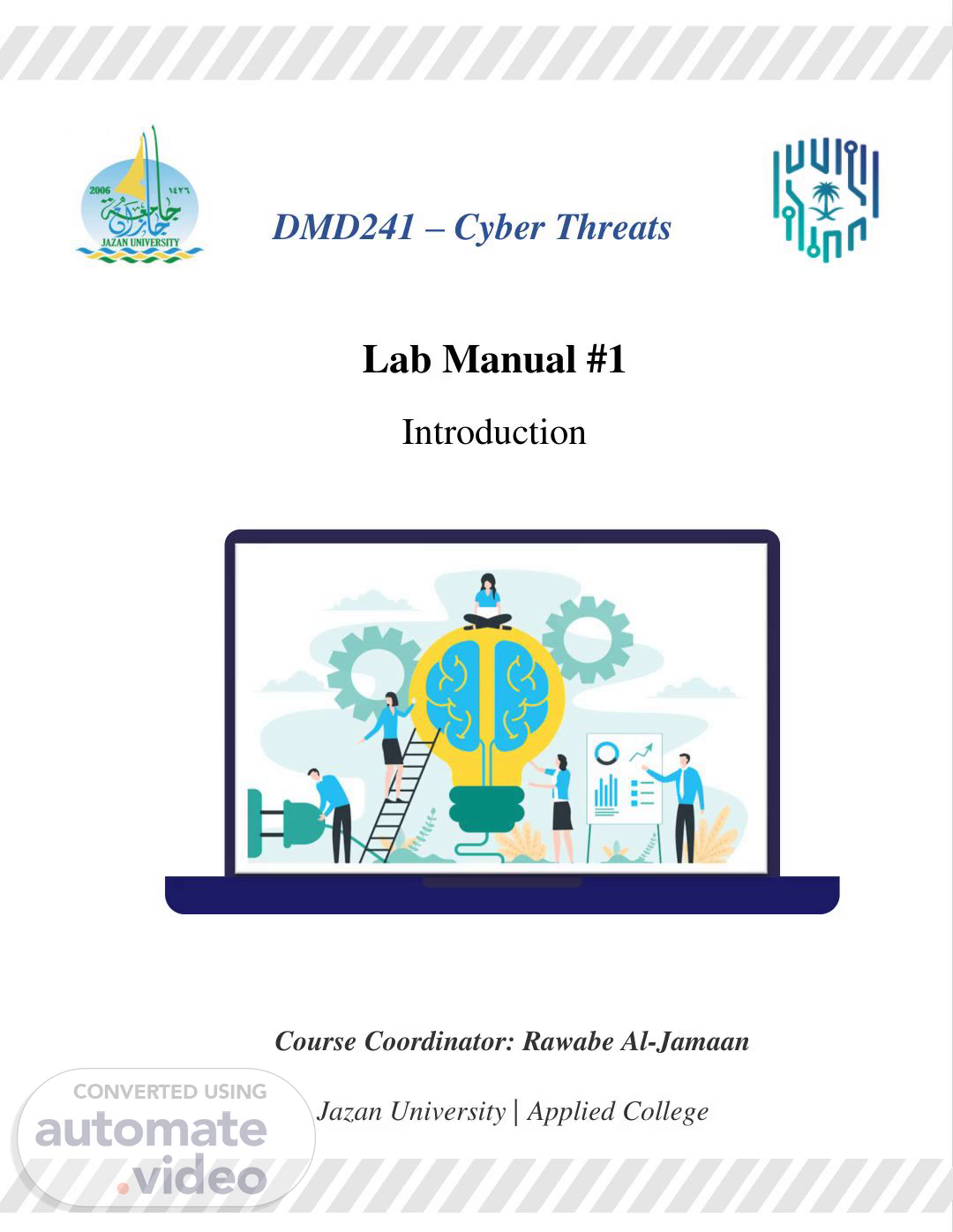Scene 1 (0s)
0 Course Coordinator: Rawabe Al-Jamaan Jazan University | Applied College DMD241 – Cyber Threats Lab Manual #1 Introduction.
Scene 2 (8s)
1 1. Lab Objectives: ▪ List, explain, and compare types of cyber-attacks. ▪ Distinguish and identify attack indication events. ▪ Categorize adversary resources, capabilities, techniques, and motivations. ▪ Practice the popular tools for performing cyber attacks using different technologies. ▪ Investigate the current cyber threats and incorporate best practices to mitigate them. ▪ learn the best tools to protect organizations from cyber threats. 2. Introduction about lab: The lab sessions will address three primary topics: installation and environment setup, popular cyber-attack tools, and best practices for cyber threats mitigation. 3. Installation and Environment Setup: During the lab sessions, the student needs two main platforms for various information security tasks: virtual machine, and Kali Linux. The minimum requirements to work on these platforms are: ▪ RAM: 2 GB (4GB recommended) ▪ CPU: 2 cores ▪ Disk space: 20 GB free (40 GB recommended) 3.1. Installing a Virtual Machine: A virtual machine is a computer file, also referred to as an image, that acts like a real computer. It can operate in a window as a separate computing environment, often to run a different operating system 1 (Kali Linux in our case). Examples of virtual machine platforms: Parallels, VirtualBox, VMware, Oracle VM, etc. Among these choices, VirtualBox will be chosen because it is free and compatible with all operating systems. 1 https://azure.microsoft.com/en-us/resources/cloud-computing-dictionary/what-is-a-virtual-machine.
Scene 3 (1m 8s)
2 3.1.1. Install the VirtualBox for Windows: 1. Go to https://www.virtualbox.org/wiki/Downloads 2. Click on “Windows hosts”, save the installer somewhere you can quickly locate it, like your Downloads folder. 3. Double-click the executable file (.exe) to launch the VirtualBox Setup wizard..
Scene 4 (1m 28s)
3 4. Click Next on the first screen. This action tells the Wizard that you want to install VirtualBox. 5. In the Custom Setup screen, browse and select the location you want to install VirtualBox in. The default location is fine, but feel free to change it if you prefer.Then, click Next when you’re ready to continue..
Scene 5 (1m 47s)
4 6. On the next screen, you’ll see a list of the shortcuts and file associations the installation will create. Check or uncheck the items you wish to include or exclude and click Next. This example leaves all options checked. 7. On the next screen, you’ll see a warning about networking. The setup process will install a virtual network adapter, which may cause your network connection to disconnect momentarily. Click Yes to continue..
Scene 6 (2m 8s)
5 8. Finally, you’ll see a screen asking you to confirm the installation. Click Install to install VirtualBox on Windows 10. 9. The installation process takes several minutes, depending on your system speed. Click Finish to close the Wizard after the installation and start using VirtualBox..
Scene 7 (2m 24s)
6 3.1.2. Install the VirtualBox for MacOS: 1. Go to https://www.virtualbox.org/wiki/Downloads 2. Click on “macOS hosts”, save the installer somewhere you can quickly locate it, like your Downloads folder. 3. Double-click on the dmg file, to mount the contents. 4. A window opens, prompting you to double-click on the VirtualBox.pkg installer file displayed in that window..
Scene 8 (2m 48s)
7 5. This starts the installer, which enables you to select where to install VirtualBox. 6. A VirtualBox icon is added to the Applications folder in the Finder. 3.2. Installing Kali Linux in a Virtual Machine: Kali Linux is a Debian-derived Linux distribution designed for penetration testing. With over 600 preinstalled penetration testing programs, it earned a reputation as one of the best operating systems used for security testing. As a security-testing platform, it is best to install Kali as a VM on VirtualBox. 1. Go to https://www.kali.org/get-kali/#kali-platforms 2. Select Virtual Machines copy..
Scene 9 (3m 17s)
8 3. Select 32/64 bits version according to your computer, then click the download icon under the VirtualBox. 4. Double click on the downloaded file (.exe/.dmg) to unzip the file. 1 2.
Scene 10 (3m 31s)
9 5. Double-click on the .vbox file. 6. VirtualBox manager window will appear, Kali Linux is on the left and it is powered off. Click Start to run it. 7. Set the username and password as you preferred..
Scene 11 (3m 46s)
10 8. This is the Kali Linux desktop. Now, all platforms are ready! We will start using all the amazing Kali tools from next manual!.
